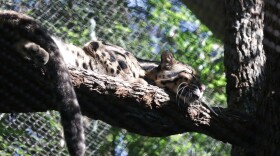UT Austin researchers named a newly discovered ancient beaver species after the popular gas station Buc-ee’s — inspired by the store's beaver mascot.
“Buc-ee’s was founded in 1982, but we may need to rethink our beginnings,” said the company's CEO, Arch “Beaver” Aplin III.
Anchitheriomys buceei, or “A. buceei,” was a beaver species native to Texas around 15 million years ago that was about 30% larger than beavers today. UT Jackson School of Geosciences researchers Steve May and Matthew Brown used a fossil collected around 80 years ago to officially identify and name the new species in their paper released Monday.
"Fossil beavers are really scarce in the fossil record of East Texas, and so to find this one was was exciting,” said Brown, director of the Texas Vertebrate Paleontology Collections at the Jackson School Museum of Earth History.
May found inspiration for A. buceei’s name when he drove past a Buc-ee’s billboard in 2020 that read, “This is Beaver Country."
“I thought, ‘Yeah, it is beaver country, and it has been for millions of years,’” May said.
The new species was identified from a partial skull collected by paleontologists in Burkeville, Texas in 1941. Curtis Hesse, a Texas A&M University museum curator, was unable to complete his study and name the species by the time he died in 1945.
Around 80 years later, May and Brown picked up Hesse’s work. May noticed the skull while looking through some of the million fossils housed at the Texas Vertebrate Paleontology Collections, Brown said.
“Steve looked at this as kind of the perfect opportunity to investigate this particular animal a little bit more,” Brown said.

While the collection has A. buceei fossils from six sites in the state, the partial skull gave researchers the most insight into the new species, Brown said. May and Brown used high-resolution X-ray imaging to notice small anatomical details in the skull.
“The partial skull that we've got is the part that had the most unique characteristics in it,” Brown said. “The anatomical details that were revealed during those processes working in the labs allowed us to recognize that it was a new species.”
Now, Brown said the researchers hope to learn more about A. buceei by looking for more fossils and researching related species.
“The fossil record is actually pretty sparse,” Brown said about beavers in Texas. “That's definitely an area where there's a lot of room for new discovery."










